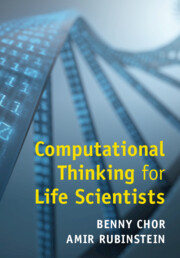Introduction
Published online by Cambridge University Press: 19 August 2022
Summary
Modern biology has been undergoing a dramatic revolution in recent decades. Enormous amounts of data are produced at an unprecedented rate. These data come in various forms, such as gene and protein expression level data, DNA, RNA, and protein sequencing, high quality biological and medical images. One consequence of this “data explosion” is that computational methods are increasingly being used in life science research. Computational methods in this context are not the mere use of tools, but the integration of computational and algorithmic thinking to lab-experiment design; to data generation, integration, and analyses; and to modeling and simulation. It is becoming widely recognized that such thinking skills should be incorporated into the standard training of life scientists in the 21st century.
Information
- Type
- Chapter
- Information
- Computational Thinking for Life Scientists , pp. 1 - 4Publisher: Cambridge University PressPrint publication year: 2022
